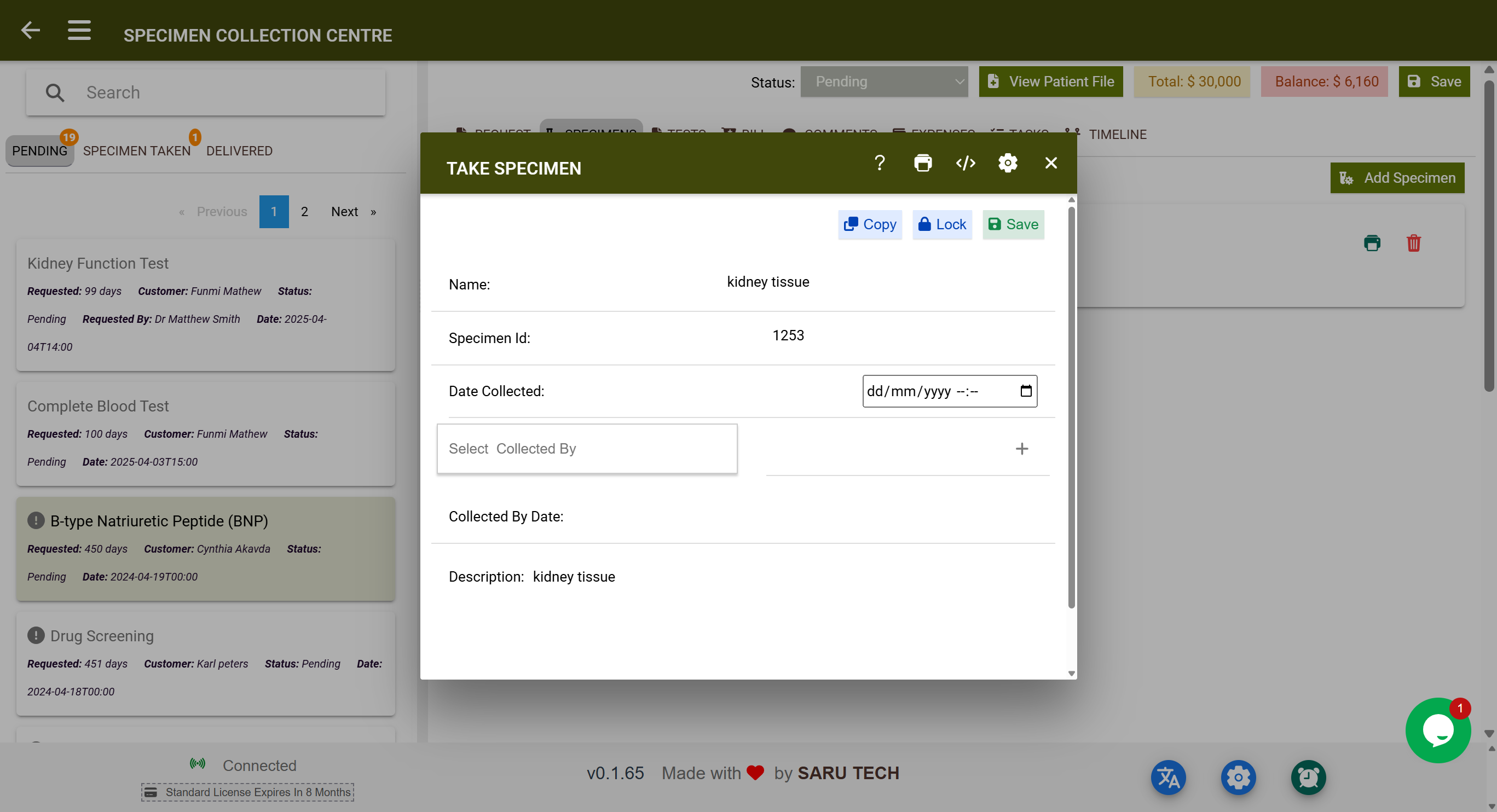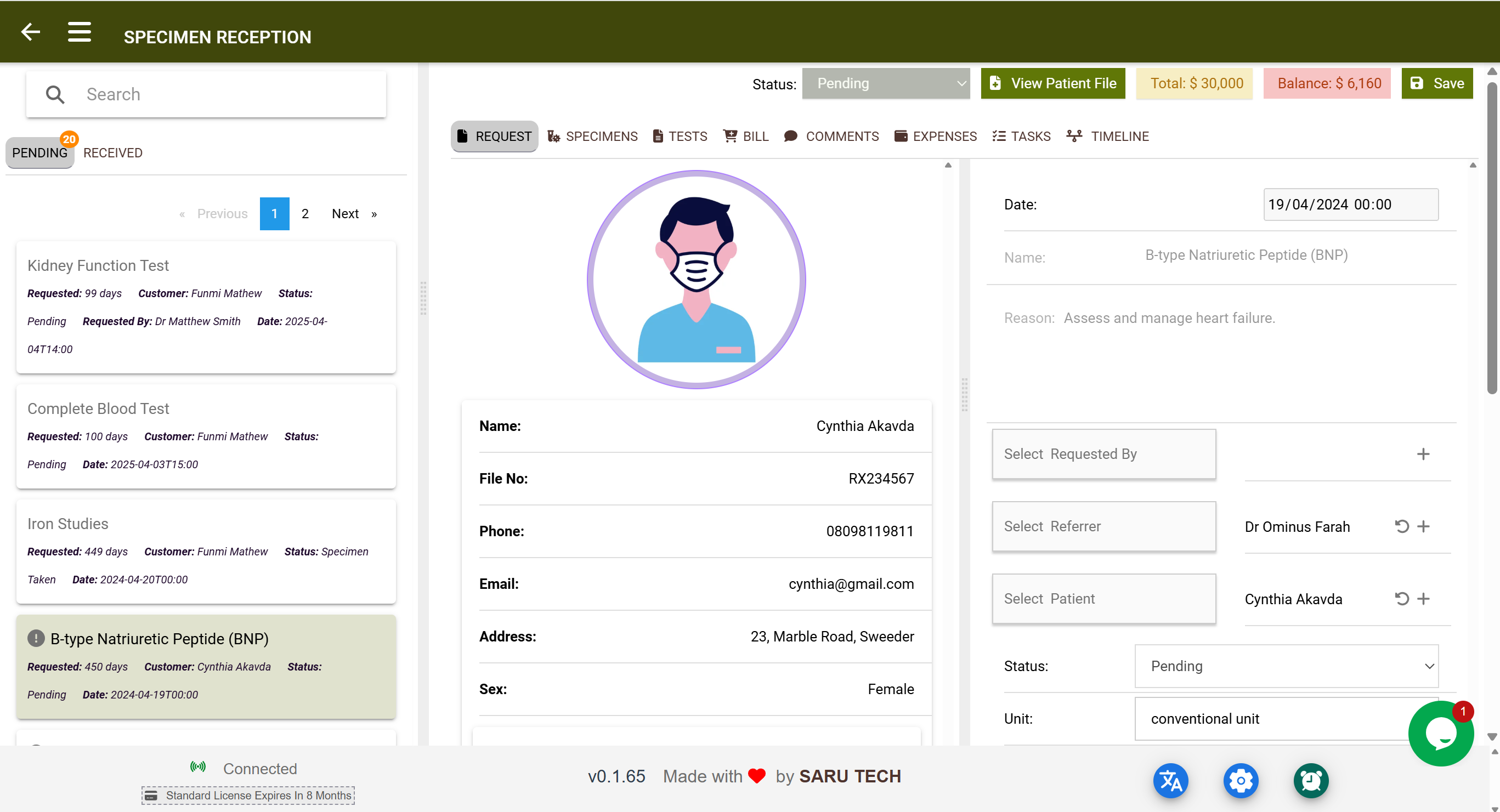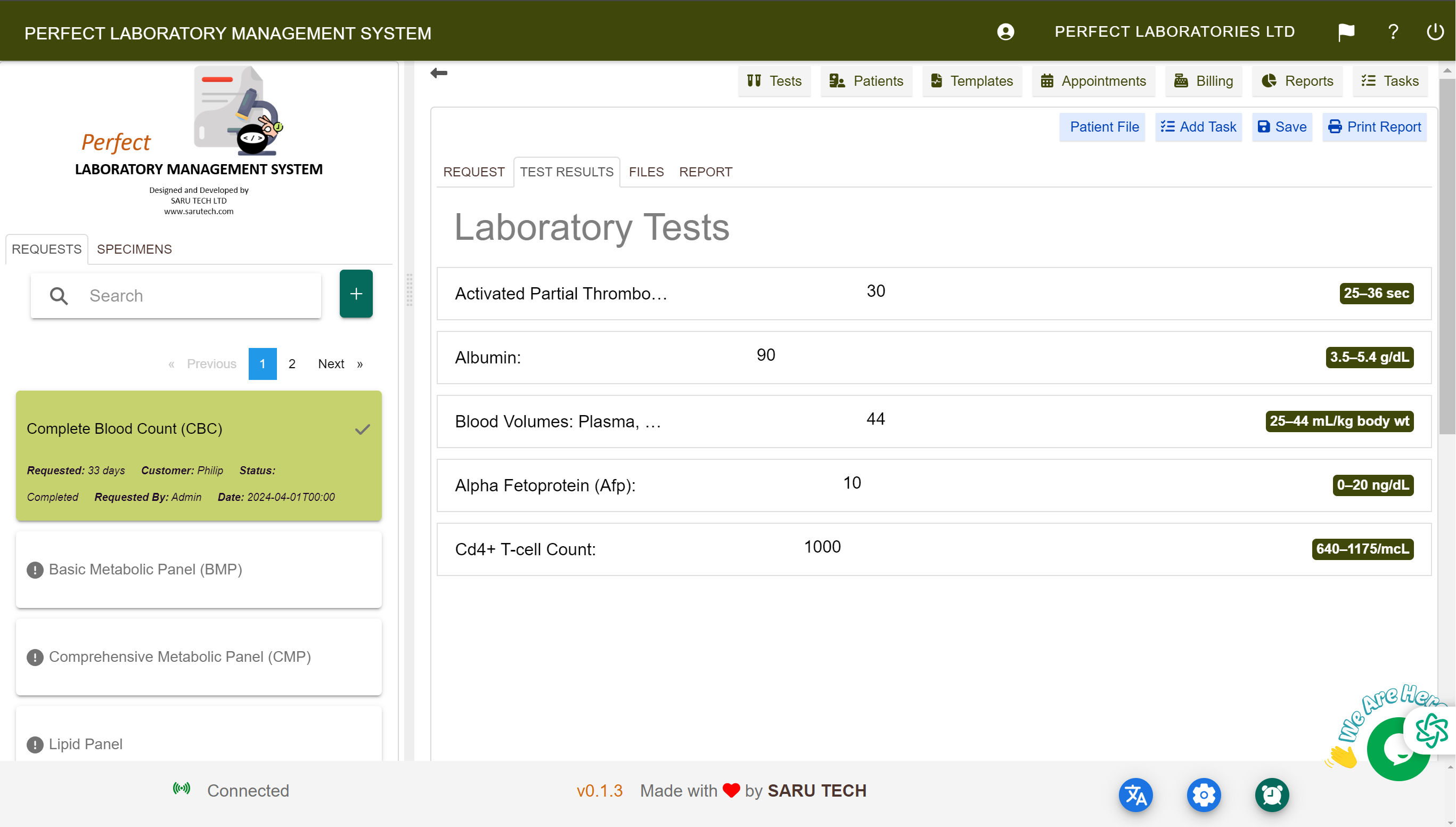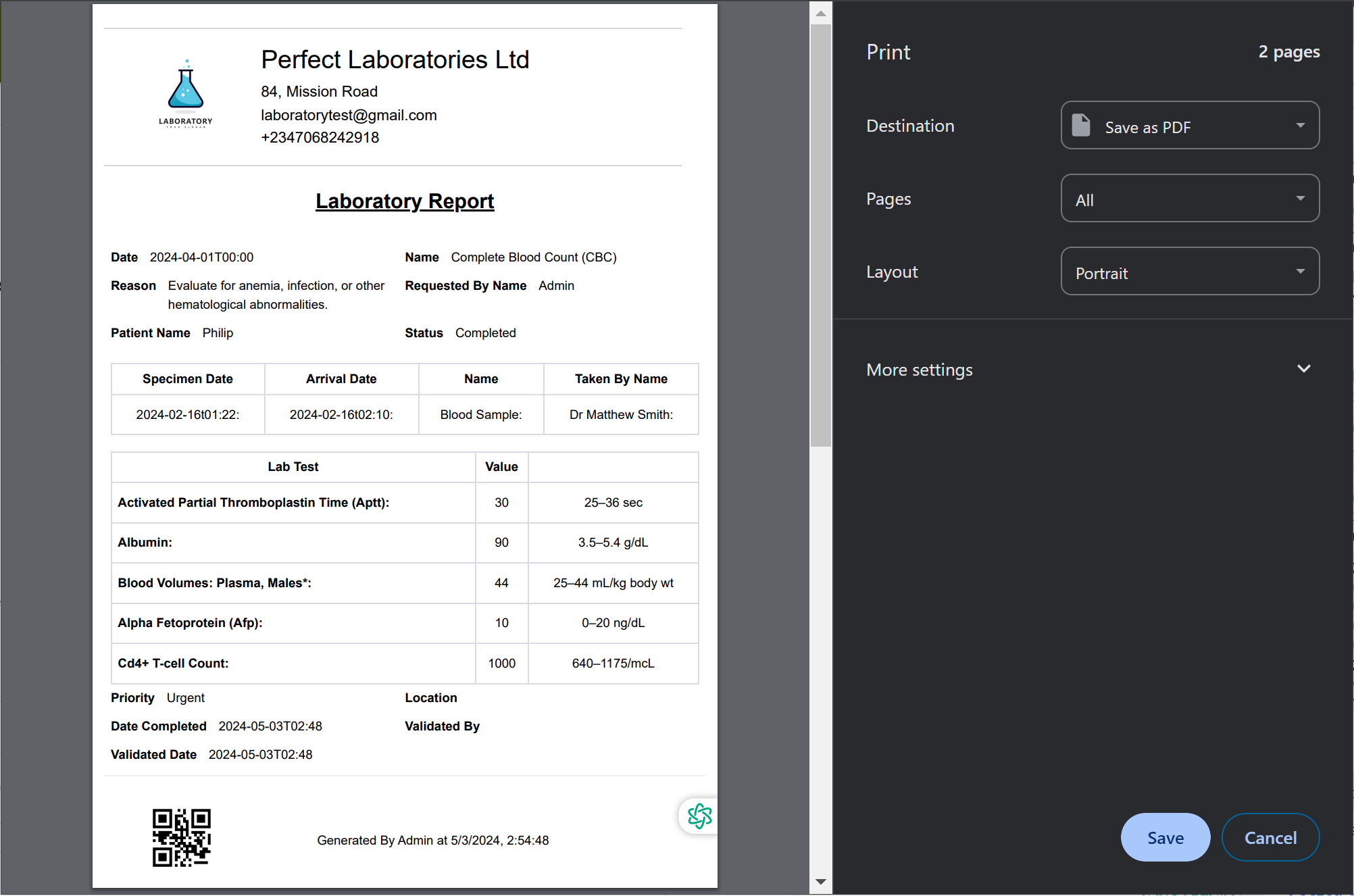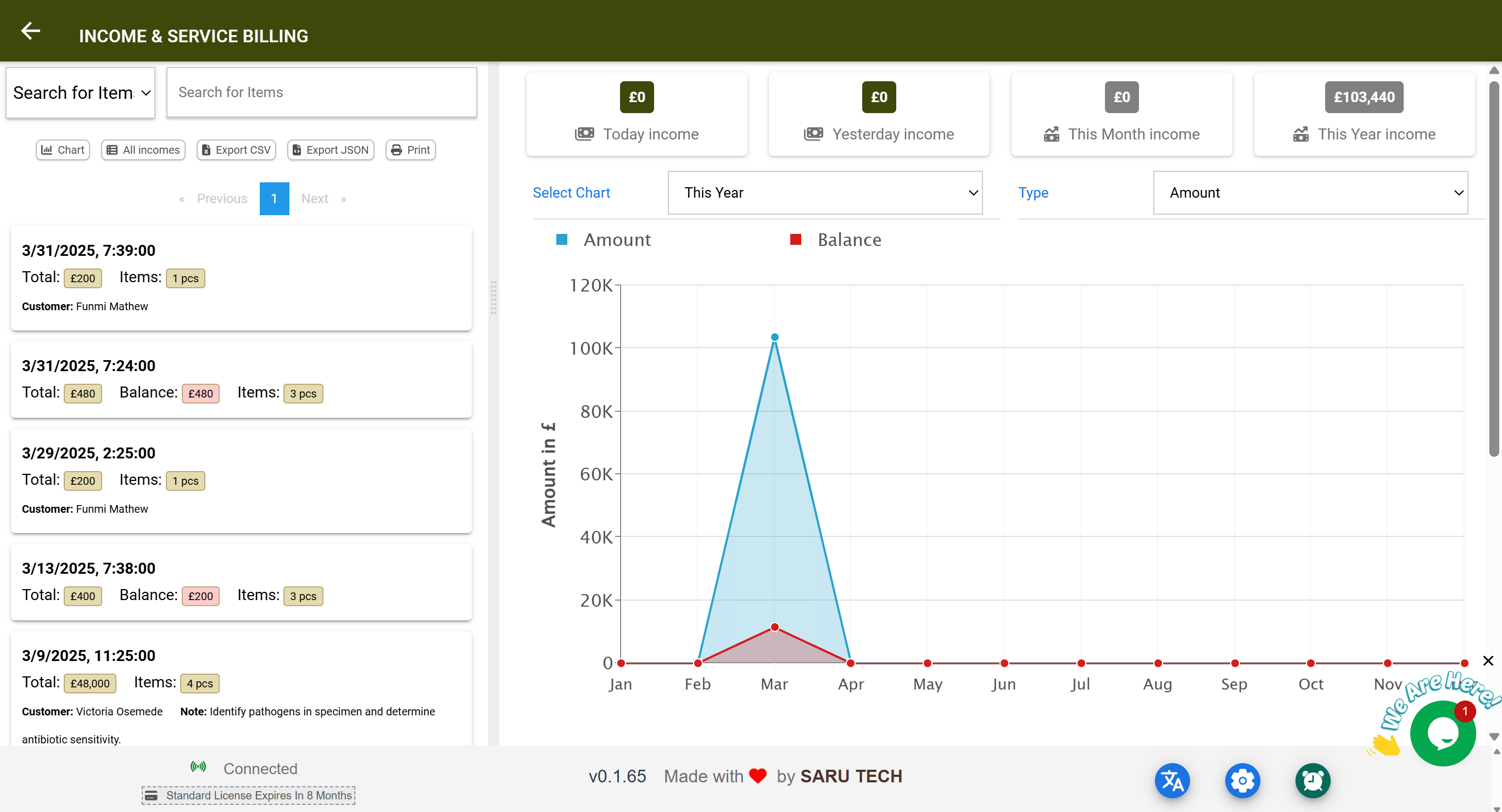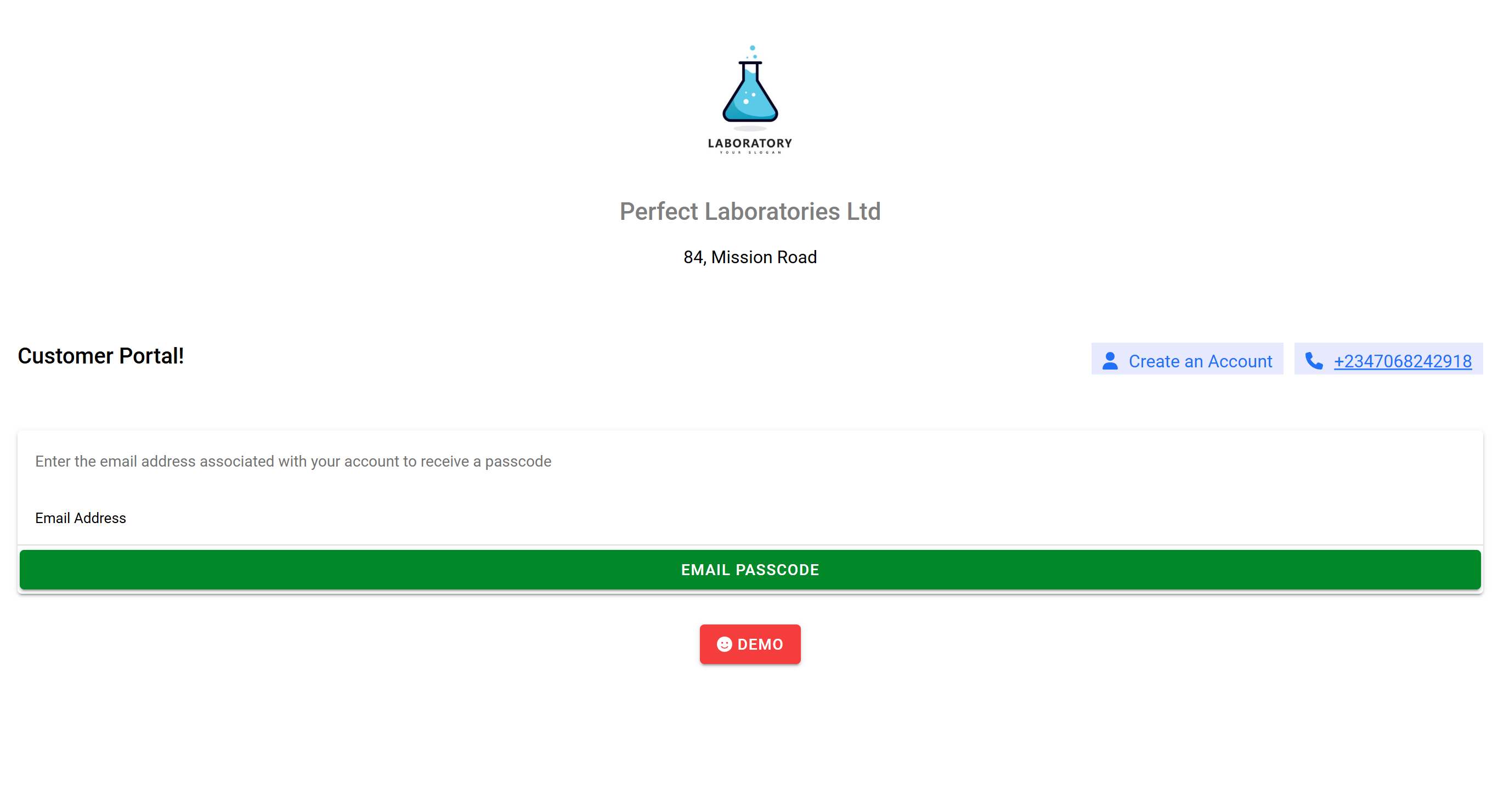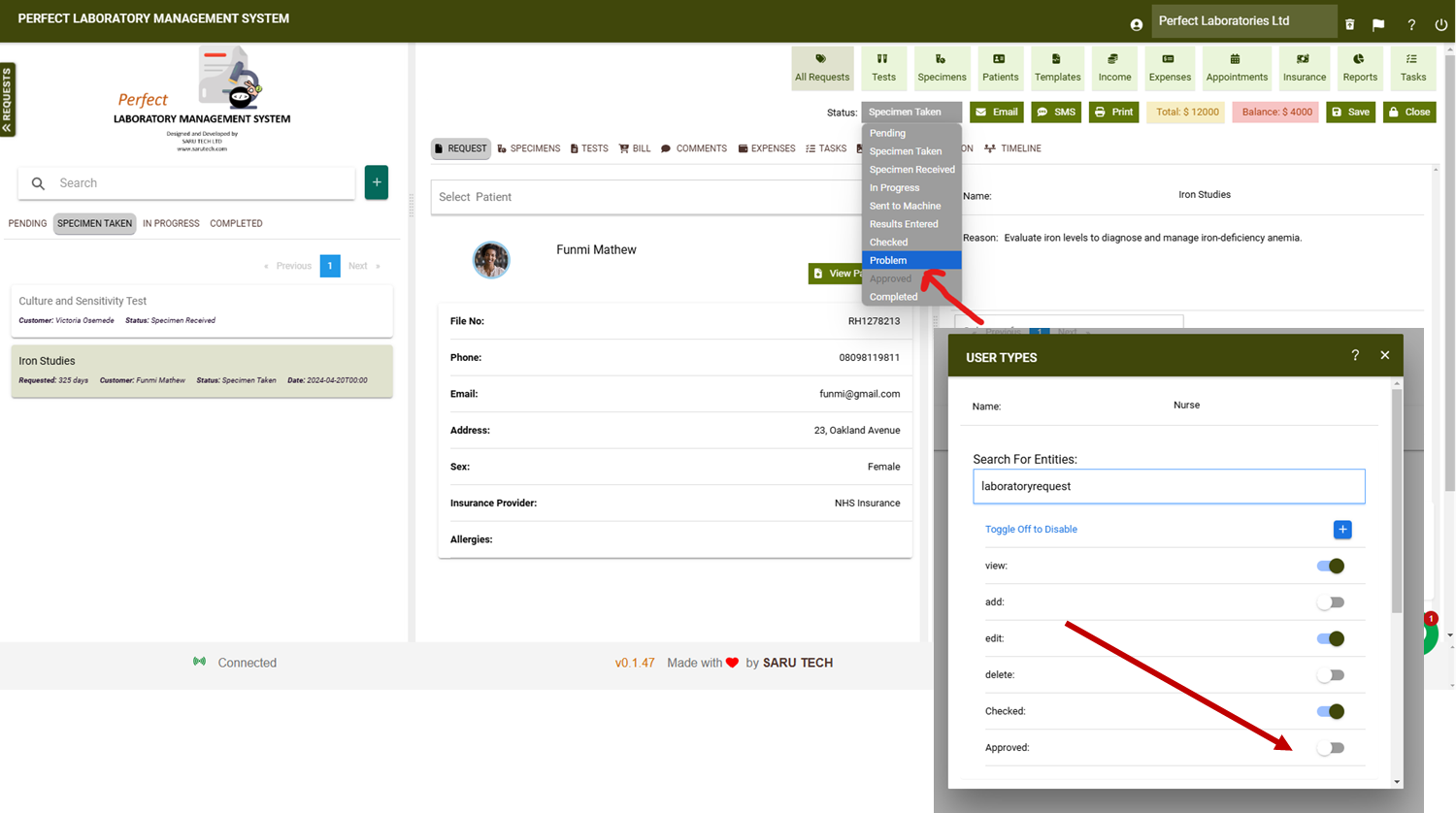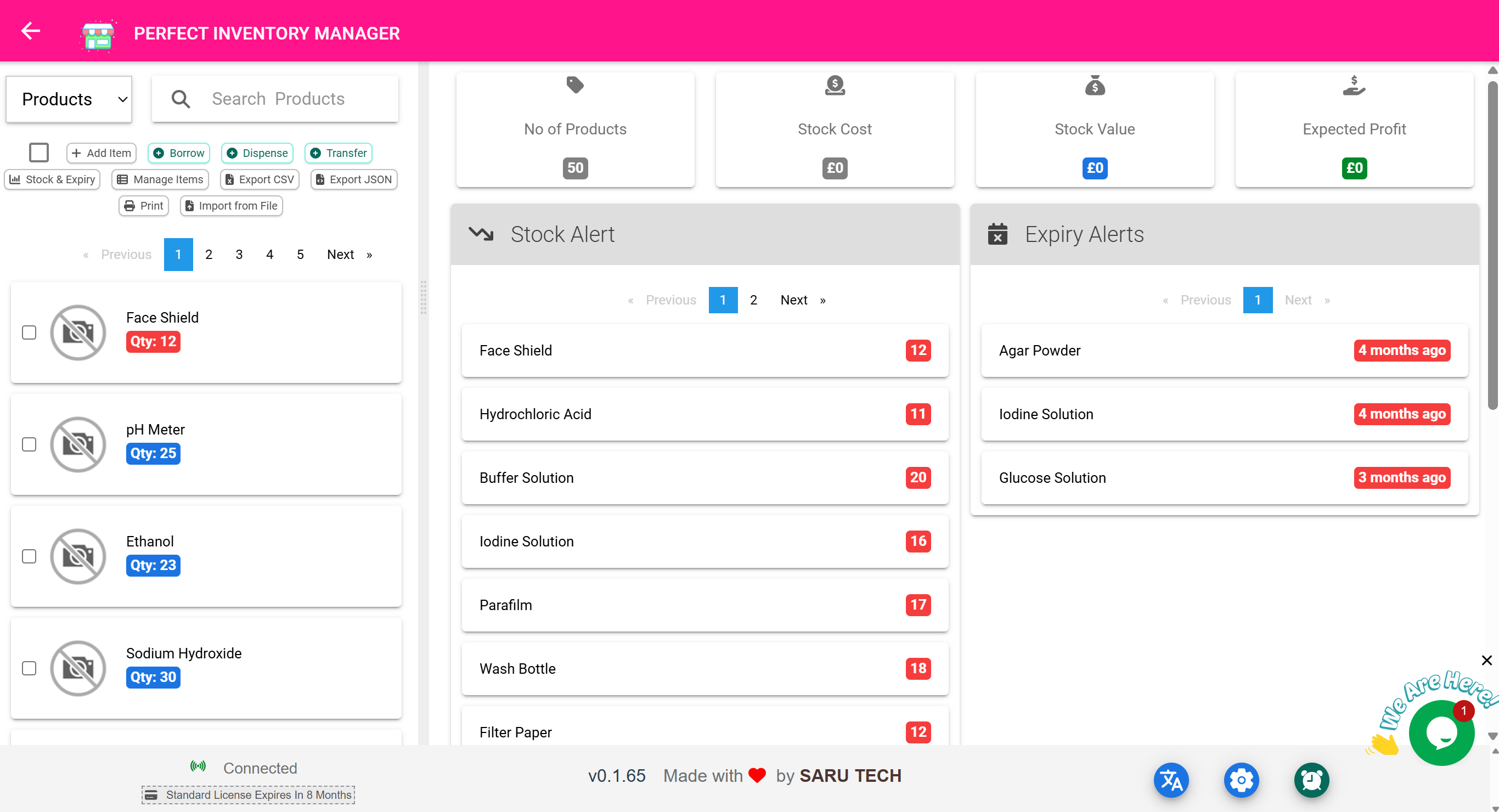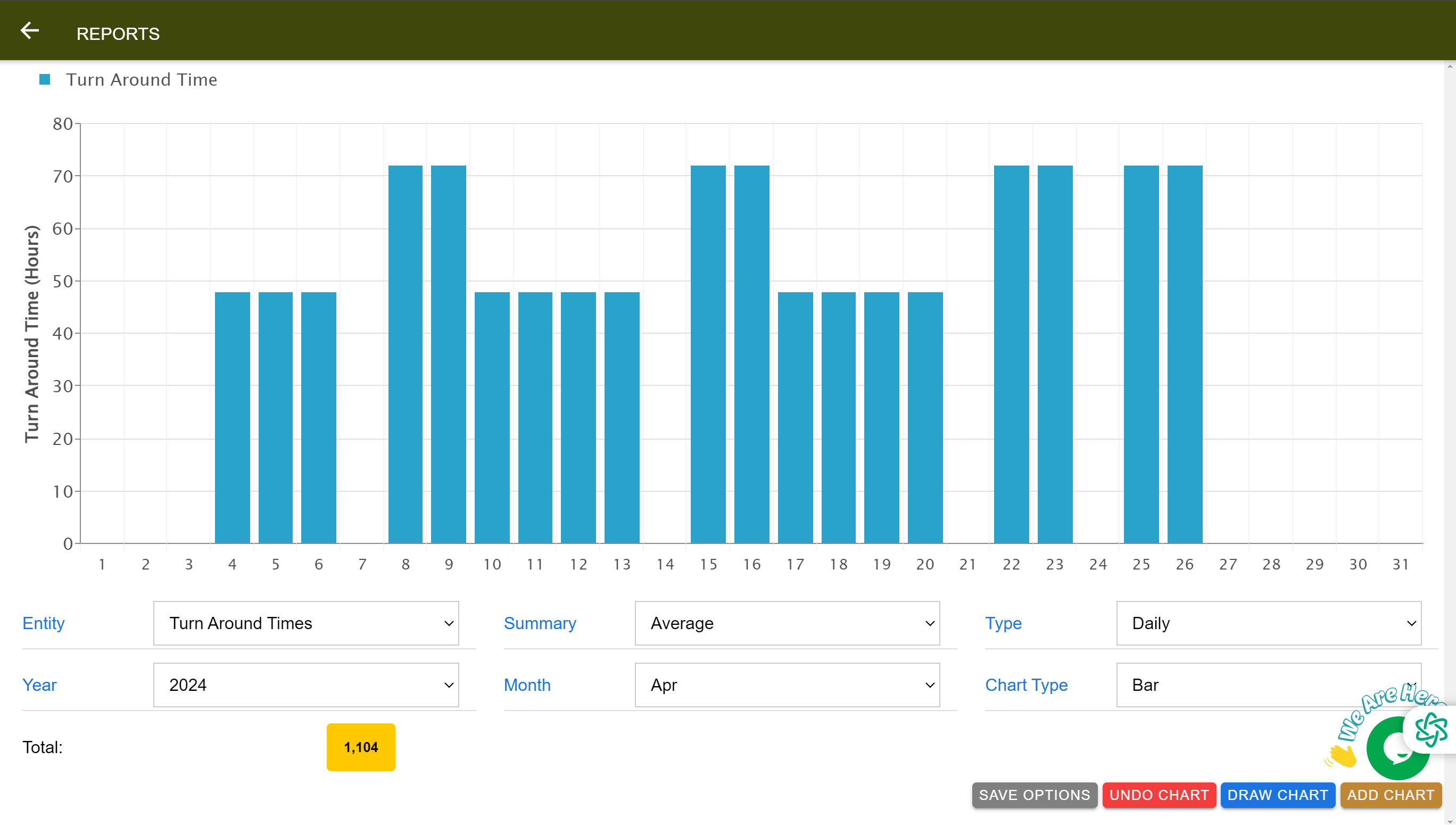Simplify Laboratory Operations
The Perfect Laboratory Management System is designed for modern labs looking to streamline daily workflows. From test request to final report, this SaaS solution empowers lab managers, technicians, and healthcare administrators to deliver faster, error-free services with complete traceability.
Whether you're running a small private lab or a multi-branch diagnostic center, this system adapts to your needs, automates routine tasks, and keeps your operations compliant and audit-ready.
Learn More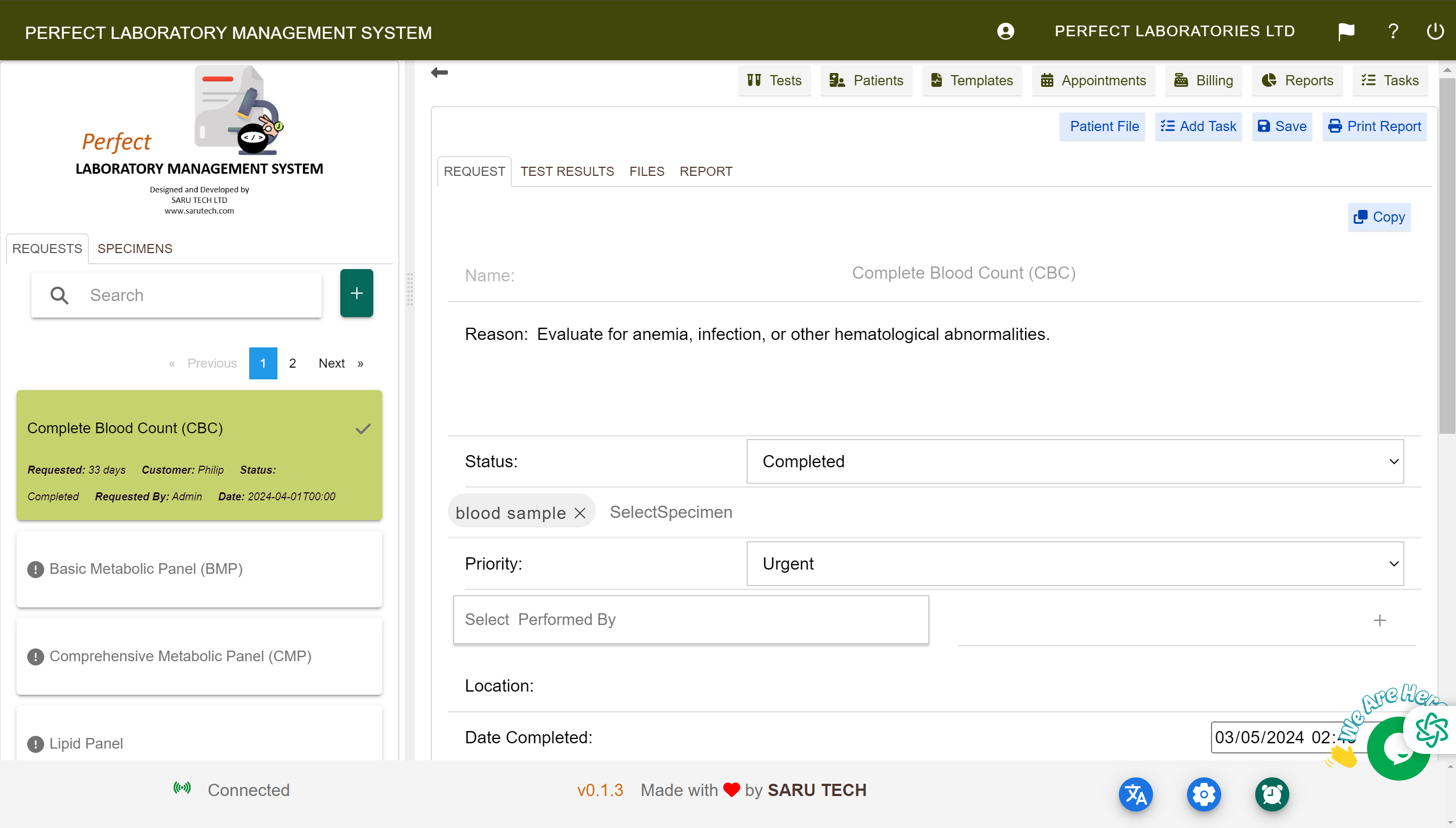
🌟 Core Features
📋 Streamlined Lab Test Request Management
Simplify how your lab handles test requests with an intuitive, centralized system. Staff can create and manage test orders directly in the platform or receive them from integrated hospital systems. Requests are automatically tagged with patient details, clinician notes, and priority levels to eliminate manual errors.
Real-time tracking allows managers to monitor every request's progress—from creation to specimen collection and result approval. Color-coded statuses and role-based workflows ensure the right team member is notified at every stage.
By digitizing requests, labs reduce paperwork, improve turnaround times, and provide better transparency for patients and clinicians.
Learn More🧫 Barcode-Enabled Specimen Collection and Tracking
Ensure full chain-of-custody from collection to processing with barcode-enabled workflows. Phlebotomists can log collection details, assign barcodes to each specimen, and print labels for error-free tracking.
The system supports collection of multiple specimens per request (e.g., blood, urine, swabs) and assigns unique identifiers for traceability. Staff receive alerts for urgent collections and rejected specimens to minimize delays.
Every step—collection, storage, and handoff—is logged with timestamps and user IDs for audit-ready records.
Learn More🔬 Secure Specimen Reception and Laboratory Intake Workflow
Improve laboratory intake with a secure and traceable specimen reception process. As specimens arrive, technicians can scan barcodes to log their entry, record storage locations, and mark them as “Received” in the system.
The platform supports outsourcing workflows where specimens are sent to external labs. Staff can log outbound and inbound transfers to ensure no samples are misplaced.
Integrated audit trails allow managers to review every specimen’s journey—from collection through testing—reducing errors and increasing accountability.
Learn More🧪 Accurate Test Result Entry and Automated Report Generation
Enter and validate test results with ease. The system supports numeric and text results, unit management (SI and conventional), and automatic flagging of abnormal values.
Use predefined conclusion templates to speed up report writing and ensure consistency across your lab’s output. Attach relevant images or external reports for a complete patient file.
Once validated, results can be reviewed and approved by supervisors before finalization, ensuring only verified data reaches clinicians and patients.
Learn More🖨️ Laboratory Report Finalization with Print, Email, and SMS Sharing
Deliver professional lab reports quickly and securely. Once results are approved, lab staff can finalize reports and share them via multiple channels: print, email, or SMS notifications to patients and referring doctors.
PDF reports include patient demographics, test results, comments, and attached images for comprehensive documentation. SMS updates notify patients when results are ready, improving communication and satisfaction.
The system also logs every communication action—ensuring a complete audit trail for compliance and transparency.
Learn More💳 Comprehensive Billing Management with CPT Codes, Split Payments, and Insurance Claims
Manage complex billing scenarios with ease. The system supports CPT codes for standardized lab procedure billing and allows split payments between patients and insurance providers.
Finance teams can reconcile insurance deposits, generate invoices automatically, and track outstanding balances with full transparency. Documents related to claims are stored securely, linked to specific providers.
Integrated SMS and email tools streamline communication with patients and insurers for reminders and receipts, reducing delays in payment collection.
Learn More🌐 Patient Management System and Self-Service Patient Portal
Centralize all patient interactions with an intuitive management dashboard. Staff can view and update patient profiles, track lab requests, manage appointments, and access billing history—all in one place.
Patients enjoy a self-service portal where they can book appointments, complete pre-visit forms, track test statuses, view past results, and make secure online payments via PayPal or Paystack.
Empower patients while reducing administrative overhead and ensuring HIPAA-compliant data handling.
Learn More🔐 Role-Based Access Control and User Permissions for Labs
Protect sensitive data with granular role-based permissions. Define exactly who can view, edit, approve, or delete records based on their role—lab technicians, supervisors, billing officers, or administrators.
The system enforces approval workflows, restricts access to certain tabs or statuses, and logs every action in a detailed timeline for auditing.
This security framework keeps labs compliant with healthcare regulations while streamlining team collaboration.
Learn More📦 Intelligent Inventory Management for Laboratory Consumables
Track reagents, consumables, and equipment across multiple stores or departments with precision. The system automatically deducts items used during test processing and supports unit-based dispensing for smaller quantities like strips or milliliters.
Borrowing, returning, and stock transfers are fully logged, while expiry alerts ensure no critical supplies are wasted. Finance teams can manage suppliers, generate purchase orders, and monitor usage trends in real time.
Streamline operations with complete visibility into stock levels and transaction history.
Learn More📊 Dynamic Report and Chart Generation for Laboratory Analytics
Visualize lab performance with interactive reports and customizable charts. Monitor turnaround times, specimen rejection rates, and test volumes across branches or technicians for data-driven decision-making.
Advanced filters let managers drill down into metrics by date range, department, or test type, providing both granular and big-picture insights into operational efficiency.
Move from reactive to proactive management with real-time analytics tailored to your lab’s needs.
Learn More🔄 Customize your Daily Workflows, with your own permissions and rules
📋 Lab Test Ordering & Billing Workflow
Step 1: Patient Arrival & Lab Test Order Entry
When a patient arrives, the clerk creates a lab test order in the system.
- ✅ Status: Set to Pending.
- ✅ Doctor Requester Name: Selected from a searchable list.
- ✅ Created By: Automatically captured (logged-in clerk).
- ✅ Date & Time: System timestamps the order.
Step 2: Auto-Billing & Payment Confirmation
The system auto-generates a bill for selected lab tests.
- ✅ Clerk reviews the bill with the patient.
- ✅ Upon payment, status changes to Ordered.
- ✅ A receipt is issued for the patient.
Step 3: Handling Cancellations
- 📄 Pending Orders: Admission desk can cancel directly (no invoice issued).
- 📄 Ordered Status: Only admins can cancel. Triggers refund or reconciliation process.
🧫 Specimen Collection & Lab Processing Workflow
Step 1: Specimen Collection
The lab clerk prints labels with patient details to prevent mix-ups, collects the required samples, and updates the system:
- ✅ Status changes to Collected.
Step 2: Lab Technician Workflow
- ✅ Status updated to Order Received.
- ✅ Specimen sent to Machine or marked as Outsourced.
Step 3: Result Entry & Approval
- ✅ Results entered manually or auto-integrated.
- ✅ Urgent notifications sent to doctors for critical variances.
- 👨⚕️ Lab doctor approves → Status: Completed.
🔗 Outsourced Lab Test Workflow
Step 1: Specimen Sent to External Lab
The lab team creates a lab request form including patient details and doctor information, then dispatches the specimen.
- ✅ Status: Specimen Outsourced.
Step 2: Result Reception & Entry
- ✅ Results received from external lab.
- ✅ Status: Outsource Received → Results entered in system.
Step 3: Result Delivery
- ✅ PDF report sent via email or printed copy signed by lab head.
- ⚠️ Critical results are sent immediately to physicians via SMS or phone call.
💡 Why Choose the Perfect Laboratory Management System?
⚡ Streamlined Workflows
Automate routine tasks like test requests, billing, and result sharing to save time and reduce human error.
🔒 Secure & Compliant
Role-based access controls and audit trails ensure compliance with healthcare data privacy regulations.
📊 Real-Time Insights
Dynamic dashboards and customizable reports give lab managers the data they need to make smarter decisions.
🌐 Patient Portal Integration
Empower patients with online appointment booking, result viewing, and secure payments through the self-service portal.
💳 Advanced Billing Capabilities
Handle complex scenarios like CPT codes, split billing, and insurance reconciliation with ease.
📦 Complete Inventory Control
Track consumables, monitor expiry dates, and manage stock levels across multiple departments or locations.
❓ Frequently Asked Questions
📋 How does the system handle multi-location labs?
The system is designed for both single-site and multi-branch laboratories. Each location can manage its own inventory, billing, and reporting while managers can view consolidated data across all branches. Learn More →
🔐 Can I control which staff have access to specific features?
Yes! Role-based access controls let you define granular permissions for each user type. For example, only lab supervisors can approve results or unlock reports, while technicians can only update test entries. Learn More →
📦 How does inventory tracking work for consumables?
Each test automatically deducts associated consumables from stock. You can track items down to sub-units (e.g., ml, pieces), set expiry alerts, and manage borrowing/returns between departments. Learn More →
💳 Does the billing system support insurance claims?
Absolutely. You can create split bills between patients and insurers, apply CPT codes for standardized billing, and track insurance reconciliation with detailed payment timelines. Learn More →
🌐 Can patients access their results online?
Yes, the integrated Patient Portal allows patients to securely log in, book appointments, fill pre-visit forms, and access their lab results online. Notifications can also be sent via SMS and email. Learn More →
🚀 Ready to Transform Your Laboratory?
Join laboratories around the world who are streamlining operations, improving accuracy, and delivering faster results with the Perfect Laboratory Management System.


